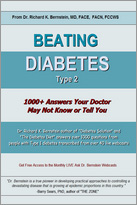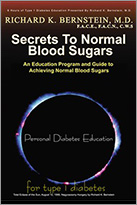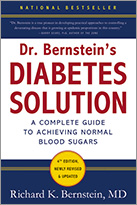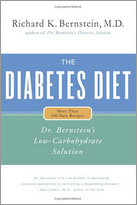In Chapter 1 we discussed how diabetics and nondiabetics might react to a particular meal. Here we’ll talk about how specific kinds of foods can affect your blood sugar.
A curious fact about diet, nutrition, and medication is that while we can make accurate generalizations about how most of us will react to a particular diet or medical regimen, we cannot predict exactly how each individual will react to a given food or medication.
The foods we consume, once you take away the water and undigestible contents, can be grouped into three major categories that provide calories or energy: protein, carbohydrate, and fat. (Alcohol also provides calories, and will be discussed later in this chapter.) Seldom will food from one of these groups contain solely one type of nutrient. Protein foods often contain fat; carbohydrate foods frequently contain some protein and some fat. The common foods that are virtually 100 percent fat are oils, butter, some types of margarine, and lard. Since our principal concern here is blood sugar control, we’ll concentrate on how these three major sources of calories affect blood sugar. If you’re a long-standing diabetic and have followed standard ADA teachings for years, you’ll find that much of what you’re about to read is radically at odds with the ADA’s dietary guidelines—and with good reason, as you’ll soon learn.
When we eat, the digestive process breaks down the three major food groups into their building blocks. These building blocks are then absorbed into the bloodstream and reassembled into the various products our bodies need in order to function.
PROTEIN
Proteins are constructed of building blocks called amino acids. Through digestion, dietary proteins are broken down by enzymes in the digestive tract into their amino acid components. These amino acids can then be reassembled not only into muscle, nerves, and vital organs, but also into hormones, enzymes, and neurochemicals. They can also be converted to glucose, but very slowly and inefficiently.
We acquire dietary protein from a number of sources, but the foods that are richest in it—egg whites, cheese, and meats (including fish and fowl)—contain virtually no carbohydrate. Protein is available in smaller amounts from vegetable sources such as legumes (beans), seeds, and nuts, which also contain fat and carbohydrate.*
Protein and carbohydrate are our two dietary sources of blood sugar. Protein foods from animal sources are only about 20 percent protein by weight (about 6 grams per ounce), the rest being fat, water, and/or undigestible “gristle.” The liver (and to a lesser degree, the kidneys and intestines), instructed by the hormone glucagon,† can very slowly transform as much as 36 percent of these 6 grams per ounce into glucose‡—if blood sugar descends too low, if serum insulin levels are inadequate, or if the body’s other amino acid needs have been met. Neither carbohydrate nor fat can be transformed into protein. In many respects—and going against the grain of a number of the medical establishment’s accepted notions about diabetics and protein—protein will become the most important part of your diet if you are going to control blood sugars.
If you are a long-standing diabetic and are frustrated with the care you’ve received over the years, you have probably been conditioned to think that protein is more of a poison than sugar and is the cause of kidney disease. I was conditioned the same way—many years ago, as I mentioned, I had laboratory evidence of advanced proteinuria, signifying potentially fatal kidney disease—but in this case, the conventional wisdom is just a myth.
Nondiabetics who eat a lot of protein don’t get diabetic kidney disease. Diabetics with normal blood sugars don’t get diabetic kidney disease. High levels of dietary protein do not cause kidney disease in diabetics or anyone else. There is no higher incidence of kidney disease in the cattle-growing states of the United States, where many people eat steak virtually every day, than there is in the states where beef is more expensive and consumed to a much lesser degree. Similarly, the incidence of kidney disease in vegetarians is the same as the incidence of kidney disease in nonvegetarians. It is the high blood sugar levels that are unique to diabetes, and to a much lesser degree the high levels of insulin required to cover high carbohydrate consumption (causing hypertension), that cause the complications associated with diabetes.
* Phosphate, a by-product of protein digestion, requires calcium in order to be eliminated from the body—about 1 gram of calcium for every 10 ounces of protein foods. If you don’t eat much cheese, cream, milk (too high in carbohydrate), yogurt, or bones, all good sources of calcium, it would be wise to take a calcium supplement. This will prevent slow loss of calcium from your bones. I recommend calcium in formulations supplemented with magnesium and vitamin D.
† And other so-called counterregulatory hormones, such as cortisol and growth hormone.
‡ This amounts to about 7.5 percent of the total weight of a protein food. Say you eat a 3-ounce (85 grams) hamburger, no bun, for lunch—the protein in it can slowly be transformed by the liver into about 6 grams of glucose.
FAT
The Big Fat Lie
Call it the Big Fat Lie. Fat has, through no real fault of its own, become the great demon of the American dietary scene. It is no myth that more than half of Americans are overweight, and the number of obese Americans is growing.
Current dietary recommendations from the government, and nearly every “reputable” organization with an opinion, are to eat no more than 30 percent of calories as fat—which very few people can maintain—and there are some recommendations for even lower percentages than that. The current low-fat mania in our culture has spawned an increase in sugar intake. All a candy or cookie has needed is the label “fat free” to send its sales through the roof. The fallacy that eating fat will make you fat is about as scientifically logical as saying that eating tomatoes will turn you red.
This is the kind of fallacious thinking behind the prevailing “wisdom,” which maintains that there is an unavoidable link between dietary protein and fat and high serum cholesterol. And that if you want to lose weight and reduce cholesterol, all you need to do is eat lots of carbohydrate, limit consumption of meat, and cut out fat as much as possible. But many contemporary researchers exploring this phenomenon have begun to arrive at the conclusion that a high-carbohydrate diet, especially rich in fruit and grain products, is not so benign. In fact, it has been shown—and it is my own observation in myself and in my patients—that such a diet can increase body weight, increase blood insulin levels, and raise most cardiac risk factors.
In an unbiased, clearheaded, and award-winning article in the respected journal Science of March 30, 2001, the science writer Gary Taubes explores what he calls “The Soft Science of Dietary Fat.” (The full text of this article is available at www.diabetes-book.com.) Taubes cites the failure of the antifat crusade to improve the health of Americans: Since the early 1970s, for instance, Americans’ average fat intake has dropped from over 40% of total calories to 34%; average serum cholesterol levels have dropped as well. . . .
Meanwhile, obesity in America, which remained constant from the early 1960s through 1980, has surged upward since then—from 14% of the population to over 22%. Diabetes has increased apace. Both obesity and diabetes increase heart disease risk, which could explain why heart disease incidence is not decreasing. That this obesity epidemic occurred just as the government began bombarding Americans with the low-fat message suggests the possibility . . . that low-fat diets might have unintended consequences—among them, weight gain. “Most of us would have predicted that if we can get the population to change its fat intake, with its dense calories,* we would see a reduction in weight,” admits [Bill] Harlan [of the NIH]. “Instead, we see the exact opposite.”
I urge you to have a look at the article, which will give you a notion of the kinds of competing personal, economic, and political interests that go into the formulation of “scientific” guidelines.
The U.S. Centers for Disease Control and Prevention (CDC) released data in the year 2000 indicating that 64.5 percent of U.S. adults were overweight and 30.5 percent were obese. Furthermore, 25 percent of obese teenagers now have type 2 diabetes. These statistics are occurring even though people are eating less fat.
* Contrary to traditional thinking, a study recently published in the Journal of the American College of Nutrition demonstrated that “fat calories” are about the same as “carbohydrate calories.”
The advent of our agricultural society is comparatively recent in evolutionary terms—that is, it began only about 10,000 years ago. For the millions of years that preceded the constant availability of grain and the more recent year-round availability of a variety of fruits and vegetables, our ancestors were hunters and ate what was available to them in the immediate environment, primarily meat, fish, some fowl, reptiles, and insects—food that was present year-round, and predominantly protein and fat. In warm weather, some may have eaten fruits, nuts, and berries that were available locally in some regions and not deliberately bred for sweetness (agriculture didn’t exist). If they stored away fat during warm periods, much of that fat was burned up during the winter. Although for the past two centuries, fruit, grain, and vegetables have, in one form or another, been available to us in this country year-round, our collective food supply has historically been interrupted often by famine—in some cultures more than others. The history of the planet as best as we can determine is one of feast (rarely) and famine, and suggests that famine will strike again and again as it has in the last few decades in a variety of places.
Curiously, what today seems in our society to be a genetic predisposition toward obesity functioned during the famines of prehistory as an effective method of survival. Ironically, the ancestors of those who today are most at risk for type 2 diabetes were, during prehistory, not the sick and dying, but the survivors. If famine struck today in the United States, guess who would survive most easily? The same people who are most at risk for type 2 diabetes. For those living in a harsh environment where the availability of food is uncertain, bodies that store fat most efficiently when food is available (for example, by being insulin-resistant and craving carbohydrate, like most type 2 diabetics) survive to reproduce.
If you give it some thought, it makes perfect sense: If a farmer wants to fatten up his pigs or cows, he doesn’t feed them meat or butter and eggs, he feeds them grain. If you want to fatten yourself up, just start loading up on bread, pasta, potatoes, cake, and cookies—all highcarbohydrate foods. If you want to hasten the fattening process, consume dietary fat with your carbohydrate. Indeed, two recent studies showed that dietary fat, when consumed as part of a high-carbohydrate diet, was converted to body fat. Fat consumed as part of a low-carbohydrate diet was metabolized, or burned off.




